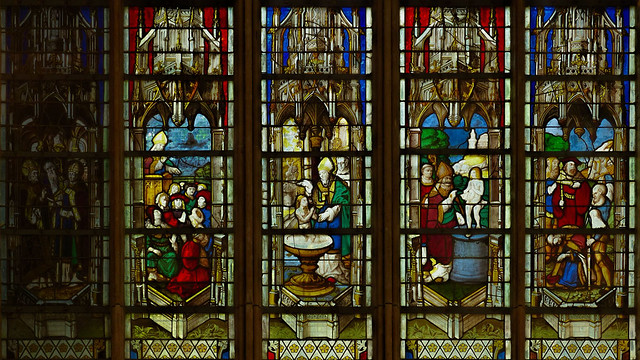The Life of St Austremoine - Abbey Church of Saint-Ouen, Rouen

This window narrates episodes from the Life of St Austremoine (St Austremonius), traditionally regarded as one of the earliest missionary bishops sent from Rome to evangelise Gaul. Executed by a Rouen workshop in the early sixteenth century, the glass follows the established Saint-Ouen formula: discrete narrative scenes set beneath elaborate Gothic canopies, combining architectural interiors with landscape backgrounds.
In the first panel, Austremoine is shown accompanied by St Baudime and St Nectaire, the companions who, according to Auvergnat tradition, assisted him in his mission. The trio appears in a landscape setting, underscoring their itinerant apostolic activity.
The next panel depicts Austremoine delivering a sermon. The saint, vested as the bishop of Clermont, addresses a gathered group of listeners; their varied poses and gestures reflect the reception of his teaching. The setting evokes the establishment of the Christian community in the region.
In the central scene, Austremoine baptises a child. The large stone font and the presence of clerics and attendants reflect the solemnity of episcopal baptism, marking the moment when new converts formally enter the faith.
The fourth panel shows a miraculous episode: the resurrection of a child who has been thrown into a well. Austremoine is shown drawing the lifeless body from the water or receiving it from assistants, while onlookers respond with amazement. This miracle, preserved in regional traditions, affirms the saint’s divine authority and bolsters his missionary preaching.
The final panel depicts the beheading, of St Austremoine. The saint kneels in resignation while the executioner raises his sword, bringing the sequence to its martyrdom climax. The scene mirrors the narrative arc common to missionary saints: evangelisation, confirmation through miracles, and ultimate witness through death.
Although partially restored and reorganised over the centuries, the window retains significant elements of the sixteenth-century Rouen manner: strong colour contrasts, crowded but clear compositions, and richly detailed canopy work. Taken together, the panels present a complete and vivid cycle of St Austremoine’s mission, miracles, and martyrdom, situating him firmly within the wider hagiographic programme that lines the nave’s south aisle.
